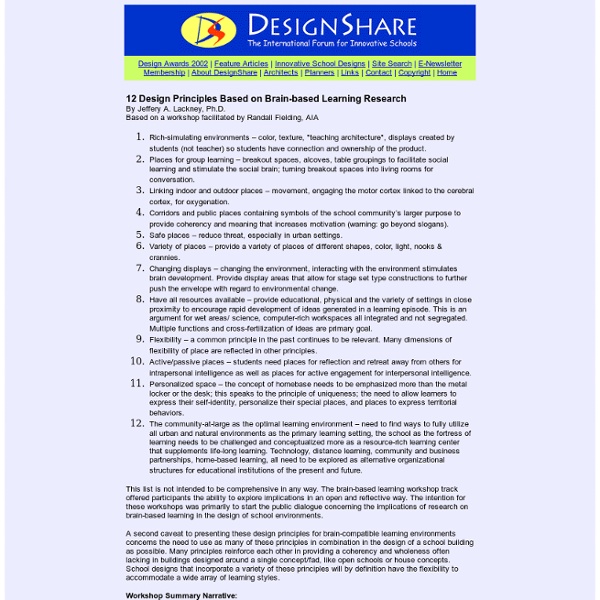Brain-based Learning Design Principles

Theory of multiple intelligences
The theory of multiple intelligences is a theory of intelligence that differentiates it into specific (primarily sensory) "modalities", rather than seeing intelligence as dominated by a single general ability. This model was proposed by Howard Gardner in his 1983 book Frames of Mind: The Theory of Multiple Intelligences. Gardner articulated seven criteria for a behavior to be considered an intelligence.[1] These were that the intelligences showed: potential for brain isolation by brain damage, place in evolutionary history, presence of core operations, susceptibility to encoding (symbolic expression), a distinct developmental progression, the existence of savants, prodigies and other exceptional people, and support from experimental psychology and psychometric findings. Gardner argues intelligence is categorized into three primary or overarching categories, those of which are formulated by the abilities. The different abilities[edit] Musical–rhythmic and harmonic[edit] Interpersonal[edit]
- Pat Wolfe – Mind Matters, Inc.
Ten things learned on my leadership journey | John Dunford Consulting
1. Be creative Dream your dreams and go into school the next day and put them into action. Although many people complain about the pressures of accountability – with some justification – there is still plenty of space for creativity in school leadership. Being creative does not necessarily mean thinking of original ideas. Creativity and innovation can come through using ideas from elsewhere and adapting them to the context of your own school. 2. When I was appointed as a head, I told the appointment committee that it was my job to water the plants. But, as in the garden, not all the human plants need the same amount of water and nurturing. 3. School leaders are part of a great movement to increase the life chances of young people by raising their aspirations and achievement. Of course, all school leaders want their school to be the best and work long hours towards that admirable goal, but this should not be at the expense of other schools. 4. 5. 6. 7. 8. 9. 10. Like this: Like Loading...
Brain-based Learning
Email Share Definition This learning theory is based on the structure and function of the brain. As long as the brain is not prohibited from fulfilling its normal processes, learning will occur. Please note: since this article was published, Geoffrey and Renate Caine, leaders in brain-based learning research, have modified their principles on the topic. Discussion People often say that everyone can learn. The core principles of brain-based learning state that: The brain is a parallel processor, meaning it can perform several activities at once, like tasting and smelling. The three instructional techniques associated with brain-based learning are: Orchestrated immersion –Creating learning environments that fully immerse students in an educational experience Relaxed alertness –Trying to eliminate fear in learners, while maintaining a highly challenging environment Active processing –Allowing the learner to consolidate and internalize information by actively processing it Reading
Distributed Leadership Page
Distributed leadership is primarily concerned with mobilizing leadership at all levels in the organisation not just relying on leadership from the top. It is about engaging the many rather than the few in leadership activity within the school and actively distributing leadership practice. The emphasis here is about leadership practice and not leadership functions. A distributed model of leadership is one premised upon the interactions between many leaders rather than the actions of an individual leader. If leadership is primarily about influence and direction then in a sense all leadership is distributed. In any organisation leadership practice [1] is fluid and emergent rather than fixed’. There are two answers to this question. So what do we know about distributed leadership [3] ? Distributed leadership is not delegation Distributed leadership is an organisational condition Distributed leadership is promoted not mandated Distributed leadership is inclusive 1. 2. Reflection
Brain-based learning, ideas, and materials
Related:
Related:



